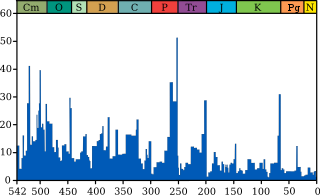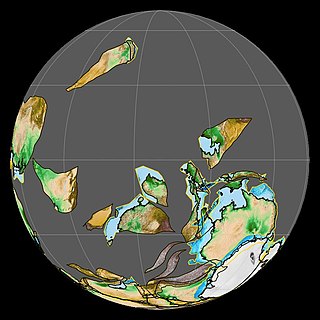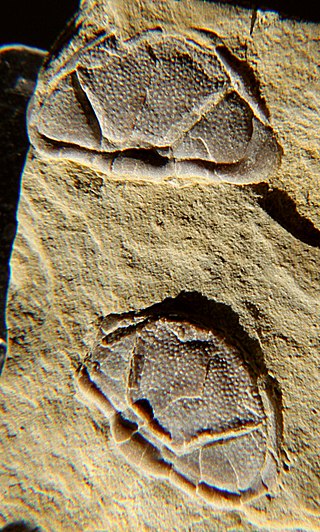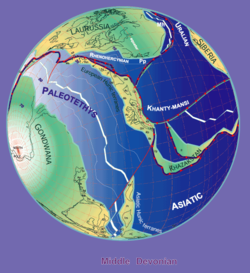
The Devonian is a geologic period and system of the Paleozoic era during the Phanerozoic eon, spanning 60.3 million years from the end of the preceding Silurian period at 419.2 million years ago (Ma), to the beginning of the succeeding Carboniferous period at 358.9 Ma. It is the fourth period of both the Paleozoic and the Phanerozoic. It is named after Devon, South West England, where rocks from this period were first studied.

The Mississippian, also known as Lower Carboniferous or Early Carboniferous, is a subperiod in the geologic timescale or a subsystem of the geologic record. It is the earlier of two subperiods of the Carboniferous period lasting from roughly 358.9 to 323.2 million years ago. As with most other geochronologic units, the rock beds that define the Mississippian are well identified, but the exact start and end dates are uncertain by a few million years. The Mississippian is so named because rocks with this age are exposed in the Mississippi Valley.

The Late Devonian extinction consisted of several extinction events in the Late Devonian Epoch, which collectively represent one of the five largest mass extinction events in the history of life on Earth. The term primarily refers to a major extinction, the Kellwasser event, also known as the Frasnian-Famennian extinction, which occurred around 372 million years ago, at the boundary between the Frasnian age and the Famennian age, the last age in the Devonian Period. Overall, 19% of all families and 50% of all genera became extinct. A second mass extinction called the Hangenberg event, also known as the end-Devonian extinction, occurred 359 million years ago, bringing an end to the Famennian and Devonian, as the world transitioned into the Carboniferous Period.
The Givetian is one of two faunal stages in the Middle Devonian Period. It lasted from 387.7 million years ago to 382.7 million years ago. It was preceded by the Eifelian Stage and followed by the Frasnian Stage. It is named after the town of Givet in France. The oldest forests occurred during the late Givetian. The lower GSSP is located at Jebel Mech Irdane, Tafilalt, Morocco.
The Famennian is the later of two faunal stages in the Late Devonian epoch. The most recent estimate for its duration is that it lasted from around 371.1 to 359.3 million years ago. An earlier 2012 estimate, still used by the International Commission on Stratigraphy, is that it lasted from 372.2 million years ago to 358.9 million years ago. It was preceded by the Frasnian stage and followed by the Tournaisian stage.

The Tournaisian is in the ICS geologic timescale the lowest stage or oldest age of the Mississippian, the oldest subsystem of the Carboniferous. The Tournaisian age lasted from 358.9 Ma to 346.7 Ma. It is preceded by the Famennian and is followed by the Viséan. In global stratigraphy, the Tournaisian contains two substages: the Hastarian and Ivorian. These two substages were originally designated as European regional stages.
The Eifelian is the first of two faunal stages in the Middle Devonian Epoch. It lasted from 393.3 ± 1.2 million years ago to 387.7 ± 0.8 million years ago. It was preceded by the Emsian Stage and followed by the Givetian Stage.

The Emsian is one of three faunal stages in the Early Devonian Epoch. It lasted from 407.6 ± 2.6 million years ago to 393.3 ± 1.2 million years ago. It was preceded by the Pragian Stage and followed by the Eifelian Stage. It is named after the Ems river in Germany. The GSSP is located in the Zinzil'ban Gorge in the Kitab State Geological Reserve of Uzbekistan, 35 centimetres (14 in) above the contact with the Madmon Formation.
The Pragian is one of three faunal stages in the Early Devonian Epoch. It lasted from 410.8 ± 2.8 million years ago to 407.6 ± 2.8 million years ago. It was preceded by the Lochkovian Stage and followed by the Emsian Stage. The most important Lagerstätte of the Pragian is Rhynie chert in Scotland. It is named after the city of Prague. The GSSP is located within the Prague Formation at Velká Chuchle, Prague.
The Lochkovian is one of three faunal stages in the Early Devonian Epoch. It lasted from 419.2 ± 3.2 million years ago to 410.8 ± 2.8 million years ago. It marked the beginning of the Devonian Period, and was followed by the Pragian Stage. It is named after the village of Lochkov in the Czech Republic, now part of the city of Prague. The GSSP is located within the Lochkow Formation at the Klonk Section in Prague.

In the geological timescale, the Middle Devonian epoch occurred during the Devonian period, after the end of the Emsian age.

The Early Devonian is the first of three epochs comprising the Devonian period, corresponding to the Lower Devonian series. It lasted from 419.2 ± 3.2 to 393.3 ± 1.2 and began with the Lochkovian Stage 419.2 ± 3.2 to 410.8 ± 1.2, which was followed by the Pragian from 410.8 ± 3.2 to 407.6 ± 1.2 and then by the Emsian, which lasted until the Middle Devonian began, 393.3± 1.2 million years ago. During this time, the first ammonoids appeared, descending from bactritoid nautiloids. Ammonoids during this time period were simple and differed little from their nautiloid counterparts. These ammonoids belong to the order Agoniatitida, which in later epochs evolved to new ammonoid orders, for example Goniatitida and Clymeniida. This class of cephalopod molluscs would dominate the marine fauna until the beginning of the Mesozoic Era.

Trimerocephalus is a genus of eyeless trilobites from the order Phacopida, family Phacopidae. It lived during the final stage of the Devonian, the Famennian, and became extinct at the end of this stage, together with all other trilobites with the exception of some Proetida. It can be found in Australia, the Czech Republic, France, Germany, Iran, Kazakhstan, Morocco, Poland, the Russian Federation (Urals), Spain, and the United Kingdom (England).

The Hangenberg event, also known as the Hangenberg crisis or end-Devonian extinction, is a mass extinction that occurred at the end of the Famennian stage, the last stage in the Devonian Period. It is usually considered the second-largest extinction in the Devonian Period, having occurred approximately 13 million years after the Late Devonian mass extinction at the Frasnian-Famennian boundary. The event is named after the Hangenberg Shale, which is part of a sequence that straddles the Devonian-Carboniferous boundary in the Rhenish Massif of Germany.
The Alexo Formation a stratigraphic unit of Late Devonian age. It is present on the western edge of the Western Canada Sedimentary Basin in the central Rocky Mountains and foothills of Alberta. The formation consists primarily of dolomite. It is locally fossiliferous and includes remains of marine animals such as brachiopods and conodonts.
The Coumiac Formation is a geologic formation in France. It preserves fossils dated to the Devonian period.
Palmatolepis is an extinct conodont genus in the family Palmatolepidae. It was the most abundant genus of conodonts of the Late Devonian, disappearing during the Devonian/Carboniferous crisis.
The Sassenach Formation is a stratigraphic unit of Late Devonian age. It is present on the western edge of the Western Canada Sedimentary Basin in the Rocky Mountains and foothills of Alberta. It consists primarily of mudstone, siltstone, and silty carbonate rocks, and was named for Mount Sassenach in Jasper National Park by D. J. McLaren and E. W. Mountjoy in 1962.
Dudleyaspis is an extinct genus of Lower to Middle Devonian odontopleurid trilobites that lived in a shallow sea that lay between Euramerica and Gondwana. It was named in 1949 by Prantl & Pribyl.
The Taghanic event was an extinction event that occurred about 386 million years ago during the Givetian faunal stage of the Middle Devonian geologic period in the Paleozoic era. It was caused by hypoxia from an anoxic event. The event had a period in which dissolved oxygen in the Earth's oceans was depleted. The Taghanic event caused a very high death rate of corals. The loss of the coral reefs caused a high loss of animals that lived in and around the reefs. The extinction rate has been placed between 28.5 and 36%, making the event the 8th largest extinction event recorded. The reduced oxygen levels resulted from a period of global warming caused by Milankovitch cycles. In the Taghanic event sea levels were higher. After the Taghanic Event, sea life recovered in the Frasnian faunal stage starting 382.7 million years ago. Two other events near this period were the Kellwasser event and the Hangenberg event.








